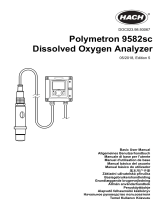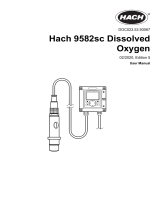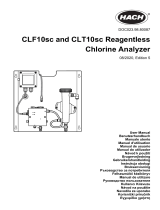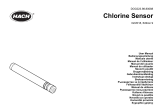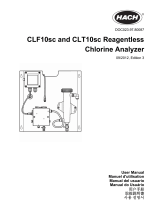Page is loading ...

FCLi with 54eA Analyzer
Instruction Manual
PN 51-FCLi-54eA rev.B
March 2012

This product generates, uses, and can radiate radio frequency
energy and thus can cause radio communication interference.
Improper installation, or operation, may increase such interfer-
ence. As temporarily permitted by regulation, this unit has not
been tested for compliance within the limits of Class A computing
devices, pursuant to Subpart J of Part 15, of FCC Rules, which
are designed to provide reasonable protection against such
interference. Operation of this equipment in a residential area
may cause interference, in which case the user at his own
expense, will be required to take whatever measures may be
required to correct the interference.
ESSENTIAL INSTRUCTIONS
READ THIS PAGE BEFORE PROCEEDING!
Your purchase from Rosemount Analytical, Inc. has
resulted in one of the finest instruments available for
your particular application. These instruments have
been designed, and tested to meet many national
and international standards. Experience indicates
that its performance is directly related to the quality
of the installation and knowledge of the user in oper-
ating and maintaining the instrument. To ensure
their continued operation to the design specifica-
tions, personnel should read this manual thoroughly
before proceeding with installation, commissioning,
operation, and maintenance of this instrument. If
this equipment is used in a manner not specified by
the manufacturer, the protection provided by it
against hazards may be impaired.
• Failure to follow the proper instructions may
cause any one of the following situations to
occur: Loss of life; personal injury; property dam-
age; damage to this instrument; and warranty
invalidation.
• Ensure that you have received the correct model
and options from your purchase order. Verify that
this manual covers your model and options. If
not, call 1-800-854-8257 or 949-757-8500 to
request correct manual.
• For clarification of instructions, contact your
Rosemount representative.
• Follow all warnings, cautions, and instructions
marked on and supplied with the product.
• Use only qualified personnel to install, operate,
update, program and maintain the product.
• Educate your personnel in the proper installation,
operation, and maintenance of the product.
• Install equipment as specified in the Installation
section of this manual. Follow appropriate local
and national codes. Only connect the product to
electrical and pressure sources specified in this
manual.
• Use only factory documented components for
repair. Tampering or unauthorized substitution of
parts and procedures can affect the performance
and cause unsafe operation of your process.
• All equipment doors must be closed and protec-
tive covers must be in place unless qualified per-
sonnel are performing maintenance.
• If this equipment is used in a manner not speci-
fied by the manufacturer, the protection provided
by it against hazards may be impaired.
Equipment protected throughout by double insulation.
• Installation of cable connections and servicing of this product
require access to shock hazard voltage levels.
• Main power and relay contacts wired to separate power
source must be disconnected before servicing.
• Do not operate or energize instrument with case open!
• Signal wiring connected in this box must be rated at least
240 V.
• Non-metallic cable strain reliefs do not provide grounding
between conduit connections! Use grounding type bushings
and jumper wires.
• Unused cable conduit entries must be securely sealed by
non-flammable closures to provide enclosure integrity in
compliance with personal safety and environmental protection
requirements. Unused conduit openings must be sealed with
NEMA 4X or IP65 conduit plugs to maintain the ingress
protection rating (NEMA 4X).
• Electrical installation must be in accordance with the National
Electrical Code (ANSI/NFPA-70) and/or any other applicable
national or local codes.
• Operate only with front and rear panels fastened and in place
over terminal area.
• Safety and performance require that this instrument be
connected and properly grounded through a three-wire
power source.
• Proper relay use and configuration is the responsibility of the
user.
This product is not intended for use in the light industrial,
residential or commercial environments per the instru-
ment’s certification to EN50081-2.
Emerson Process Management
2400 Barranca Parkway
Irvine, CA 92606 USA
Tel: (949) 757-8500
Fax: (949) 474-7250
http://www.rosemountanalytical.com
© Rosemount Analytical Inc. 2012
WARNING
RISK OF ELECTRICAL SHOCK
WARNING
CAUTION

About This Document
This manual contains instructions for installation and operation of the FCLi-54eA
The following list provides notes concerning all revisions of this document.
Rev. Level
Date Notes
A 4/08 This is the initial release of the product manual. The manual has been
reformatted to reflect the Emerson documentation style and updated to
reflect any changes in the product offering.
B 03/12 Update addresses - mail and web and DNV certification notice

i
MODEL FCLI-54eA TABLE OF CONTENTS
FCLi-54eA
TABLE OF CONTENTS
Section Title Page
1.0 DESCRIPTION AND SPECIFICATIONS ................................................................ 1
1.1 Applications and Features ..................................................................................... 1
1.2 Specifications-General ............................................................................................. 2
1.3 Ordering Information ................................................................................................ 3
2.0 INSTALLATION ....................................................................................................... 5
2.1 Unpacking and Inspection........................................................................................ 5
2.2 Installation................................................................................................................ 5
3.0 WIRING.................................................................................................................... 9
3.1 General .................................................................................................................... 9
3.2 Power, Alarm, and Output Wiring............................................................................. 9
4.0 DISPLAY AND OPERATION ................................................................................... 13
4.1 General Description ................................................................................................. 13
4.2 Display ..................................................................................................................... 13
4.3 Key Functions and Controls..................................................................................... 13
4.4 Alarm Status............................................................................................................. 13
5.0 PROGRAMMING THE ANALYZER ........................................................................ 15
5.1 Changing Alarm Setpoints ....................................................................................... 21
5.2 Ranging the Outputs ................................................................................................ 22
5.3 Test Outputs and Alarms.......................................................................................... 23
5.4 Chosing Display Options.......................................................................................... 24-25
5.5 Changing Output Parameters .................................................................................. 26-27
5.6 Changing Alarm Parameters.................................................................................... 28-31
5.7 Configuring the pH Measurement ............................................................................ 32
5.8 Temperature Compensation and Temperature Units ............................................... 33
5.9 Noise Reduction....................................................................................................... 34
5.10 Main Sensor Calibration Parameters ....................................................................... 35
5.11 Security ....................................................................................................................36
5.12 Analyzer Mode Priority............................................................................................. 37
6.0 CALIBRATION - TEMPERATURE .......................................................................... 39
6.1 Introduction .............................................................................................................. 39
6.2 Temperature Calibration........................................................................................... 40

Section Title Page
7.0 CALIBRATION CHLORINE .................................................................................... 41
7.1 Introduction .............................................................................................................. 41
7.2 Zeroing the Sensor .................................................................................................. 42
7.3 Full Scale Calibration ............................................................................................... 43
7.4 Dual Slope Calibration ............................................................................................. 44
8.0 CALIBRATION - CURRENT OUTPUTS ................................................................. 47
8.1 Introduction .............................................................................................................. 47
8.2 Trimming the Outputs............................................................................................... 47
9.0 MAINTENANCE ..................................................................................................... 49
9.1 Analyzer ................................................................................................................... 49
9.2 Chlorine Sensor ....................................................................................................... 50
9.3 Constant Head Flow Controller................................................................................ 52
10.0 TROUBLESHOOTING ........................................................................................... 55
10.1 Overview .................................................................................................................. 55
10.2 Troubleshooting When a Fault Message is Showing ............................................... 55
10.3 Troubleshooting When No Fault Message is Showing - Temperature ..................... 56
10.4 Troubleshooting When No Error Message is Showing - Chlorine............................ 56
10.5 Troubleshooting When No Error Message is Showing - General ............................ 59
10.6 Simulating Inputs - Chlorine..................................................................................... 59
10.7 Simulating Inputs - Temperature............................................................................... 60
LIST OF TABLES
Number Title Page
5.1 Program Settings List ............................................................................................... 15-17
5.2 Controller Mode Priority Chart.................................................................................. 37
10.2 Troubleshooting When a Fault Message is Showing ............................................... 55
10.4 Troubleshooting When No Error Message is Showing - Chlorine ............................ 56
10.5 Troubleshooting When No Error Message is Showing - General............................. 59
MODEL FCLi-54eA TABLE OF CONTENTS
TABLE OF CONTENTS CONT’D
ii

LIST OF FIGURES
Number Title Page
2-1 Chlorine Sensor Parts .............................................................................................. 7
2-2 Model FCLi-01-230................................................................................................... 8
3-1 Power Input and Relay Output Wiring for Model 54eA ............................................ 10
3-2 Wiring Label .................................................................................................... 11
3-3 Wiring Sensor to Model 54eA Analyzer ...................................................................... 11
4-1 Main Display Screen ................................................................................................ 13
5-1 Menu Tree for the 54eA Controller .......................................................................... 18-20
5-2 Low Alarm ................................................................................................................ 30
5-3 High Alarm................................................................................................................ 30
5-4 Interval Timer............................................................................................................ 31
7-1 Sensor Current as a Function of Free Chlorine Concentration ................................ 41
7-2 Dual Slope Calibration.............................................................................................. 44
9-1 Chlorine Sensor Parts ............................................................................................. 51
9-2 Replacement Parts for the Flow Controller Assembly .............................................. 53
10-3 Three-Wire RTD Configuration................................................................................. 60
10-4 Simulating RTD Inputs.............................................................................................. 60
iii

Model FCLi-54eA SECTION 1.0
DESCRIPTION AND SPECIFICATIONS
SECTION 1.0.
DESCRIPTION AND SPECIFICATIONS
1
• COMPLETE SYSTEM INCLUDES sensor, connecting cable, analyzer, and flow controller
• SENSOR RESPONSE IS PRACTICALLY INDEPENDENT of pH between pH 6 and 10
• NO REAGENTS
• NO AUXILIARY pH ELECTRODE
• VARIOPOL QUICK-DISCONNECT FITTINGS makes sensor replacement easy
1.1 APPLICATIONS AND FEATURES
TheFCLi free chlorine system is intended for the
determination of free chlorine (hypochlorous acid plus
hypochlorite ion) in fresh water. Unlike other free chlo-
rine analyzers, the FCLi does not use expensive sam-
ple conditioning systems or messy reagents to control
pH. Nor, does it require an auxiliary pH sensor for pH
correction. Instead, the pH adjustment takes place
inside the sensor, producing a signal that changes
less than 4% per unit change in pH between pH 6 and
10. Below pH 6.5 the change is less than 1%. The lin-
ear range of the sensor is 0 to 20 ppm (mg/L).
The FCLi is not intended for the determination of total
or combined chlorine (like monochloramine). Nor, can
the FCLi be used for the determination of chlorine in
seawater.
The FCLi uses a three electrode, membrane-covered
amperometric sensor. The sensor consists of a
hydrophilic membrane stretched over a gold mesh
cathode. A silver/silver chloride reference electrode
and an external copper auxiliary electrode complete
the circuit. The fill solution is saturated succinic acid
slurry. During operation, an electrochemical reaction,
driven by the polarizing voltage, consumes free chlo-
rine at the cathode surface. The auxiliary electrode
provides the electrons for the cathode reaction, and
a current proportional to the reaction rate flows
between the electrodes. Because the concentration of
chlorine at the cathode is zero, free chlorine in the
sample continuously diffuses through the membrane
and is destroyed at the cathode. Thus, the cathode
current is proportional to the diffusion rate, which is
proportional to the concentration of free chlorine in the
sample.
The FCLi sensor requires neither sample pretreatment
nor pH correction. All amperometric free chlorine
sensors generate a raw current that depends primarily
on the concentration of hypochlorous acid. Because
the fraction of free chlorine present as hypochlorous
acid is a function of pH, readings will be in error if the
sample pH changes from the value it had during
calibration. To correct for pH changes, some manufac-
turers treat the sample with acid to convert hypochlo-
rite to hypochlorous acid. Others continuously
measure the pH and use the pH value to correct the
chlorine sensor reading. The FCLi is different. The
sensor uses a highly buffered acidic fill solution for
internal pH adjustment. The fill solution converts all
the free chlorine entering the sensor as well as much
of the free chlorine at the outside surface of the mem-
brane into hypochlorous acid. Thus, the sensor
response is practically independent of pH.
Maintenance is fast and easy. Replacing a membrane
requires no special tools or fixtures. A screw cap holds
the pre-tensioned membrane in place. Replacing the
membrane and fill slurry takes only a few minutes.
The FCLi includes the easy-to-use Model 54eA ana-
lyzer. The analyzer features two fully programmable 4-
20 mA analog outputs and three alarm relays.
Programming and calibration is simple and intuitive.
The large backlit, display allows the user to read chlo-
rine at a single glance.
Valves, rotameters, and pressure regulators to control
sample flow are things of the past with the FCLi. A
constant head overflow sampler ensures the correct
flow to the sensor no matter how much the sample
flow or pressure changes. To eliminate wiring hassles,
quick disconnect Variopol cable is standard.
Stable free chlorine standards do not exist. The chlorine
sensor must be calibrated using the results of a
laboratory test on a grab sample.

1.2 SPECIFICATIONS — GENERAL
Sample requirements:
Pressure: 3 to 65 psig (122 to 549 kPa abs)
A check valve in the inlet opens at 3 psig (122
kPa abs). If the check valve is removed, mini-
mum pressure is 1 psig (108 kpa abs).
Temperature: 32 to 122°F (0 to 50°)
Minimum Flow: 2 gal/hr (7.6 L/hr)
Maximum flow: 80 gal/hr (303 L/hr); high flow
causes the overflow tube to back up.
Sample Conductivity: >10 µS/cm
Process connection: 1/4-in OD tubing compression
fitting (can be removed and replaced with barbed
fitting for soft tubing).
Drain connection: 3/4-in barbed fitting. Sample must
drain to open atmosphere.
Wetted parts:
Overflow sampler: acrylic, polycarbonate,
polyester, Kynar
1
, nylon, silicone
Chlorine sensor: PVC, Viton
2
, silicone, polyether-
sulfone, polyester, and copper
pH sensor: Tefzel
2
, Viton, glass, ceramic
Response time to step change in chlorine concen-
tration: <120 sec to 90% of final reading for inlet
sample flow of 2 gph (7.6 L/hr).
Weight/shipping weight:
Model FCLi-01: 10 lb/13 lb (4.5 kg/6.0 kg)
Model FCLi-02: 11 lb/14 lb (5.0 kg/6.5 kg)
[rounded to the nearest 1 lb. (0.5 kg)]
SPECIFICATIONS — SENSOR
Free chlorine range: 0 to 20 ppm as Cl
2
. For higher
ranges, consult the factory.
Accuracy: Accuracy depends on the accuracy of the
chemical test used to calibrate the sensor
Linearity (0-20 ppm): 1% per IEC 60746
Linearity (0-2 ppm): ±0.05 ppm following calibration
at 2 ppm
Sensitivity to pH: Between pH 6.5 and 10, sensor
signal changes <4% per unit change in pH. Below
pH 6.5 the change is
<1% per unit change in pH.
Interferences: Monochloramine, dichloramine, and
permanganate
Electrolyte life: 3 months (approx.)
SPECIFICATIONS — 54eA ANALYZER
Case: Epoxy-painted cast aluminum, NEMA4X (IP65).
Display: Three-line, back-lit, dot matrix LCD. First line is
measurement reading. Second line is temperature
and current output. Third line is user-selectable.
Character heights: 1st line - 0.6 in. (16 mm) , 2nd
and 3rd lines - 0.3 in. (7 mm) .
Ambient Temperature and Humidity: 0 to 50°C (32
to 122°F). 95% (maximum) non-condensing.
Analyzer can be operated between -20 and 60°C
(-4 to 140°F) with some degradation in display
quality.
Power: 100-127 Vac ± 10%, 50/60 Hz ± 6%, 8 W
200-253 Vac ± 10%, 50/60 Hz ± 6%, 8 W
RFI/EMI: EN-61326
LVD: EN-61010-1
Outputs: Two 4-20 mA or 0-20 mA isolated outputs.
Continuously adjustable. Output dampening
is user-selectable. Maximum load at 115/230
Vac is 600Ω. Maximum load at 100/200 Vac is
550Ω.
Alarms: Three alarm relays for chlorine or tempera-
ture. Fully programmable. Fourth relay for
analyzer/sensor fault.
Relay: Relays 1-3: Form A, SPST, epoxy sealed
Relay 4: Form C, SPDT, epoxy sealed
2
MODEL FCLi-54eA SECTION 1.0
DESCRIPTION AND SPECIFICATIONS
1
Kynar is a registered trademark of Elf Atochem North America.
2
Viton and Tefzel are registered trademarks of DuPont
Performance Eastomers.
Resistive Inductive
28 Vdc 5.0 3.0
115 Vac 5.0 3.0
230 Vac 5.0 1.5

3
1.3 ORDERING INFORMATION
Model FCLi Free Chlorine Measuring System. The FCLi is a complete system for the determination of free
chlorine in aqueous samples. It consists of a sensor, analyzer, and constant head flow controller. All components
are mounted on a backplate. Three replacement membranes and enough electrolyte chemicals to fill the sensor
three times are shipped with each sensor.
MODEL FCLi FREE CHLORINE MEASURING SYSTEM
FCL
i
-01 -230 EXAMPLE
MODEL FCLi-54eA SECTION 1.0
DESCRIPTION AND SPECIFICATIONS
CODE pH CORRECTION (required selection)
01 Without pH sensor
CODE ANALYZER
230
54eA-01
ANALYZER MODEL DESCRIPTION
54eA-01 54eA analyzer 115/230 Vac
SENSOR MODEL DESCRIPTION
498CL-01-VP pH-independent free chlorine sensor with Variopol connector
SENSOR CABLE DESCRIPTION
23645-13 Interconnecting cable, Variopol for 498CL sensor, 4 ft
COMPONENT PARTS
PART # DESCRIPTION
9240048-00 Tag, stainless steel (specify marking)
ACCESSORIES
SPARE PARTS
PART # DESCRIPTION
33970-00
Fill plug
33968-00
Membrane retainer
9550094
O-ring, 2-014, Viton
®
23501-10 pH-independent free chlorine membrane assembly, includes one membrane assembly
and O-ring
23502-10 pH-independent free chlorine membrane assembly, includes three membrane assem-
blies and three O-rings
24146-00
pH-independent free chlorine sensor electrolyte kit, includes three bottles of saturated
succinic acid and three bottles of succinic acid crystals

This page left blank intentionally
MODEL FCLi-54eA SECTION 1.0
DESCRIPTION AND SPECIFICATIONS
4

SECTION 2.0.
INSTALLATION
MODEL FCLi-54eA SECTION 2.0
INSTALLATION
2.1 UNPACKING AND INSPECTION
Inspect the shipping container. If it is damaged, contact the shipper immediately for instructions. Save the box. If
there is no apparent damage, unpack the container. Be sure all items shown on the packing list are present. If
items are missing, notify Rosemount Analytical immediately.
2.1.1 FCLi-01-230 (free chlorine without pH sensor)
Model consists of the following items mounted on a back plate.
1. The 54eA-01 analyzer with sensor cable attached.
2. Constant head overflow sampler with flow cell for chlorine sensor.
The free chlorine sensor (498CL-01-VP) is in a separate package. The sensor is shipped with three membrane
assemblies and enough electrolyte chemicals to fill the sensor three times.
2.2 INSTALLATION
2.2.1 General Information
1. Although the system is suitable for outdoor use, do not install it in direct sunlight or in areas of extreme
temperature.
2. To keep the analyzer enclosure watertight, install plugs (provided) in the unused cable openings.
3. Install the system in an area where vibrations and electromagnetic and radio frequency interference are
minimized or absent.
4. Be sure there is easy access to the analyzer and sensors.
2.2.2 Sample Requirements
Be sure the sample meets the following requirements:
1. Temperature: 32 to 122ºF (0 to 50ºC)
2. Pressure: 3 to 65 psig (122 to 549 kPa abs)
3. Minimum flow: 2 gal/hr (7.6 L/hr)
5
The FCLi free-chlorine analyzer is NOT suitable for
use in hazardous areas.
CAUTION

6
MODEL FCLi-54eA SECTION 2.0
INSTALLATION
2.2.3 Mounting and Making Inlet and Drain Connections
The FCLi is intended for wall mounting only. Refer to Figure 2-2 for details.
A 1/4-inch OD tubing compression fitting is provided for the sample inlet. If desired, the compression fitting can
be removed and replaced with a barbed fitting. Do not remove the check valve. The threads are 1/4-inch FNPT.
The sample drains through a 3/4-inch barbed fitting. Attach a piece of soft tubing to the fitting and allow the waste
to drain to open atmosphere. Do not restrict the drain line.
Remove the foam packing insert between the outer tube and the inner overflow tube. Adjust the sample flow
until the water level is even with the central overflow tube and excess water is flowing down the tube. Confirm that
sample is flowing through the flow cell.
2.2.4 Electrical Connections
Refer to Section 3.0 for wiring details.
2.2.5 Installing the Sensor
1. The chlorine sensor leaves the factory with a shipping membrane in place. The shipping membrane
must be removed and replaced with the chlorine membrane before putting the sensor in service. The
chlorine membrane is in a plastic bag attached to the sensor. Do not remove the shipping membrane
until you are ready to put the sensor in service.
a. Remove the red protective cap from the end of the sensor.
b. Holding the membrane end pointing up (cable connector end pointing down), unscrew the retainer cap
and remove the shipping membrane. See Figure 2.1. It is not necessary to remove the O-ring. Save the
shipping membrane. It should be reinstalled on the sensor when the sensor is not in use.
c. Still holding the membrane end pointing up, install the chlorine membrane. The chlorine membrane is in
the plastic bag attached to the sensor. Screw the retainer back in place.
2. Install the sensor in the flow cell as shown in Figure 2.2. The chlorine sensor sits in the flow cell and is held
in place by the union nut. Be sure to slip the union nut over the sensor before connecting the cable to the
sensor.
3. The Model FCLi is provided with sensor cable pre-wired to the analyzer. The terminal end of the sensor is
keyed to ensure proper mating with the cable receptacle. Once the key has slid into the mating slot, tighten
the connection by turning the knurled ring clockwise.
NOTE
Once power has been applied to the analyzer, configure it to measure free chlorine. See
section 5.4 for details. Do not connect the sensor to the cable until the analyzer has been
properly configured.
NOTE
Do not connect the sensor to the cable until the analyzer has been
configured to measure free chlorine. See section 5.4 for details.

7
Model FCLi-54eA SECTION 2.0
INSTALLATION
FIGURE 2-1. Chlorine Sensor Parts
fill plug
o-ring
membrane
assembly
membrane
retainer cap
cable
end
NOTE
Once the chlorine sensor has been connected to the analyzer and power applied, the sensor must be
placed in the flow cell filled with water.
Generally, the sensor must be in a continously flowing sample. However, the sensor can tolerate loss of
sample flow for about four days as long as it remains immersed in water in the flow cell
. There is a check
valve in the sample inlet to prevent water from draining out of the flow cell.
If the sensor sits too long in a stagnant sample, copper ions from oxidation of the external copper
electrode can diffuse into the sensor. Once inside the sensor the copper undergoes an electrochemical
reaction that greatly increases the background current and can potentially damage the sensor. See
step 2 in Section 7.2 for more information.
Do not store the chlorine sensor in air. The membrane will dry out. If the membrane dries out, it must be
replaced.

8
MODEL FCLi-54eA SECTION 2.0
INSTALLATION
FIGURE 2-2. Model FCLi-01-230
CHECK VALVE
CHLORINE SENSOR
INLET
DRAIN
INCH
MILLIMETER

SECTION 3.0.
WIRING
MODEL FCLi-54eA SECTION 3.0
WIRING
9
3.1 GENERAL
WARNING
Electrical installation must conform to the National Electrical Code, all state and local codes, and all plant
codes and standards for electrical equipment. Electrical installation and wiring must be done by qualified
personnel.
The five holes in the bottom of the instrument case accept 1/2-in. strain relief connectors or conduit fittings. The
rear openings are for power and alarm relay wiring. The left front opening is for sensor wiring (already installed)
and the right front opening is for analog output wiring. Seal unused openings with conduit plugs.
3.2 POWER, ALARM, AND OUTPUT WIRING
Refer to Figure 3-1. Make power and alarm connections on TB3. Make analog output wiring connections on TB2. For
access to power and alarm terminals, loosen the screw holding the protective cover in place and remove the cover.
Alarm contacts are dry (i.e., not powered) and are normally open. Refer to Section 1.0 for relay specifications.
For best EMI/RFI protection, shield the output cable and enclose it in an earth-grounded, rigid, metal conduit.
Connect the outer shield of the output cable to the earth ground connection on TB2 (see Figure 3-1).
Keep sensor and output signal wiring separate from power wiring. Do not run sensor and power cables in the same
conduit or close together in a cable tray.
AC wiring must be 14 gauge or greater. Be sure to connect earth ground from the power cable to the nearby
ground lug. A good earth ground is necessary for proper operation of the controller. Provide a switch or breaker to
disconnect the analyzer from the main power supply. Install the switch or breaker near the analyzer and label it as
the disconnecting device.
NOTE
The 54eA analyzer leaves the factory configured to measure dissolved oxygen, not free chlorine.
Before connecting the sensor to the cable, configure the analyzer to measure free chlorine. See
section 5.4
Live voltages may be present. Will
cause severe injury or death
DANGER
WARNING
RISK OF ELECTRICAL SHOCK
AC connections and grounding must comply with UL
508 or local electrical code. DO NOT apply power to
the analyzer until all electrical connections are veri-
fied and secure.
WARNING

MODEL FCLi-54eA SECTION 3.0
WIRING
10
FIGURE 3-1. Power Input and Relay Output Wiring for 54eA
DWG. NO. REV.
454EPH02 D

11
MODEL FCLi-54eA SECTION 3.0
WIRING
FIGURE 3-2. Wiring Label
3.3 SENSOR WIRING
3.3.1 General
The wiring label is a general purpose label. It
has wiring information concerning other
sensors, for example, contacting and inductive
conductivity sensors, that can be used with the
54e instrument platform. The FCLi is provided
with sensor cable pre-wired to the analyzer. If
it is necessary to replace the cable, refer to
Figures 3-2 (wiring label) and 3-3 (wiring dia-
gram).
DWG. NO. REV.
40054e03 A
FIGURE 3-3. Wiring Sensor to Model 54eA Analyzer

This page left blank intentionally
12
MODEL FCLi-54eA SECTION 3.0
WIRING

13
MODEL FCLi-54eA SECTION 4.0
DISPLAY AND OPERATION
SECTION 4.0
DISPLAY AND OPERATION
4.1 GENERAL DESCRIPTION
The 54eA analyzer is a single input, dual output instru-
ment.
4.2 DISPLAY
Figure 4-2 shows the main display.
4.3 KEY FUNCTIONS AND CONTROLS
The keys labeled F1, F2, F3, and F4 are multi-function.
The function appears in the main display just above the
key. For example, F1 is usually labeled Exit and F4
may be labeled Edit, Save, or Enter.
1. To enter the main menu, press any key.
2. Use the é and ê keys to move the cursor to the
desired sub-menu. The position of the cursor is
shown in reverse video.
NOTE
When the last item of a menu has been
reached, the cursor will be on the third line
of the display. If the cursor is on the second
line of the display more items remain.
Continue pressing the ê key.
3. Press Enter (F4) to access a sub-menu or an item
in a sub-menu.
4. To change a number or a setting press Edit (F4).
The display will change to show the cursor on the
first digit or on a + or - sign. Use the é and ê keys
to increase or decrease a digit or to toggle the +
and - signs. Use the ç and è keys to move the
cursor left and right.
5. If an entire number or a word is highlighted, use the
é and ê keys to scroll through the list of choices.
6. To store a number or setting in memory, press
Save (F4).
7. To leave without storing changes, press Esc (F3).
8. To leave and return to the previous screen, press
Exit (F1).
9. To end a calibration step and leave the previous
calibration in place, press Abort (F1).
10. Occasionally, information screens will appear. To
leave the information screen and move to the next
screen press Cont (F3).
4.4 ALARM STATUS
Green LEDs (labeled 1, 2, and 3) indicate when alarm
relays 1, 2, and 3 are energized. The fourth relay indi-
cates a fault condition. When a fault occurs, the red
LED (labeled FAIL) lights up, a descriptive error mes-
sage appears, and the outputs and alarm relays act as
described in Section 5.6 under fault value.
The red LED also indicates when the interval timer
routine is activated and when the time limit has been
reached on a feed limit timer. For more information on
these subjects, see Section 5.6.
FIGURE 4-1. Main Display Screen
Chlorine is always displayed continuously in large
numerals. The temperature and output current are
always displayed on the second line of the main display.
The third line can be configured by the user. In the exam-
ple, the third line shows the alarm setpoint and the raw
sensor current in nA.
1.00 ppm
26.2°C. 12.00 mA
AL1: 0.20ppm I: 340 nA

This page left blank intentionally
14
MODEL FCLi-54eA SECTION 4.0
DISPLAY AND OPERATION
/
